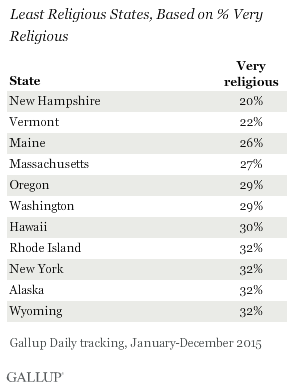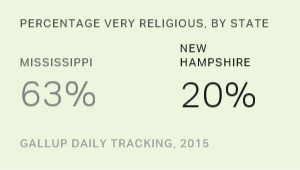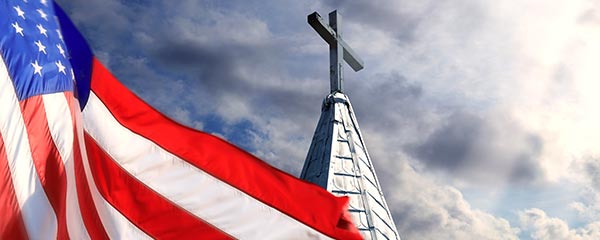Story Highlights
- 20% in New Hampshire very religious, compared with 63% in Mississippi
- Most religious states continue to be in South, along with Utah
- Least religious states in Northeast and Northwest, plus Hawaii
PRINCETON, N.J. -- New Hampshire is the least religious state in the U.S., edging out Vermont in Gallup's 2015 state-by-state analysis. Mississippi has extended its eight-year streak as the most religious state, followed closely by neighboring Alabama.


These state-by-state results are based on over 174,000 interviews conducted as part of Gallup Daily tracking in 2015, including more than 480 interviews in every state and more than 1,000 interviews in most states. Complete results and sample sizes are shown at the end of the article.
Gallup classifies Americans into three religious groups based on their responses to a question measuring religious service attendance and how important religion is in their daily life. Very religious Americans are those who say religion is important to them and who attend services every week or almost every week. Nonreligious Americans are those for whom religion is not important and who seldom or never attend religious services. Moderately religious Americans meet just one of the criteria, either saying religion is important or that they attend services almost every week or more.
Gallup began tracking several religious indicators on a daily basis in 2008. Some of these indicators have shown significant change over this time, most notably the percentage of Americans who report no formal religious identity when asked to name their religious preference. But the percentage classified as very religious on the basis of their attendance and view on the importance of religion has stayed remarkably stable. In 2008, 41% of Americans were very religious, 29% moderately religious and 30% nonreligious. In 2015, those same percentages are almost identical: 40%, 29% and 31%, respectively.

Over the past eight years, New Hampshire and Vermont have vied for the bottom position on Gallup's ranking of the most religious states. This year, New Hampshire comes in two percentage points lower than Vermont, and those two states are significantly lower in religiosity than the next two states, also in New England: Maine and Massachusetts.
New Hampshire is in the national spotlight this week as the presidential candidates focus on next Tuesday's primary in the Granite State. According to entrance polls of Iowa caucus voters, Ted Cruz's win in the GOP caucus on Feb. 1 in Iowa was driven by his strong appeal to highly religious or evangelical Republicans -- who turned out in large numbers. Although Iowa as a state has only average religiosity, it is still significantly more religious than New Hampshire, suggesting that Cruz will have fewer evangelicals to bring out to vote in that state's primary.
However, the next contest in the GOP campaign, the Feb. 20 South Carolina primary, will take place in the nation's seventh most religious state. More broadly, as is usually the case, the overall most religious states are mainly in the South. In addition to Mississippi, Alabama and South Carolina, these include Louisiana, Tennessee, Arkansas, Georgia, North Carolina, Kentucky and Texas. Utah, with the majority of its population identifying as Mormons (the most religious group in the U.S.), is the only non-Southern state among the top states for religiosity.

As has been the case since 2008, the least religious states generally are those in the two northern corners of the country. Rhode Island and New York join New Hampshire, Vermont, Massachusetts and Maine in the Northeast, while Oregon, Washington, Wyoming and Alaska are among the least religious states in the Northwest. The one additional state among the least religious is Hawaii.
Implications
The basic geographic structure of religion in America is stable, with only minor fluctuations in religiousness at the state level from year to year. The most religious states continue to be in the South, along with Utah, while the least religious Americans tend to live in the Northeast, in the Northwest, and in Alaska and Hawaii.
There are many explanations for the variations in religiosity by state, including the historical and cultural norms and patterns of each state, the types of people who choose to migrate to specific states and, to some degree, the demographic composition of the states.
Religion today is significantly linked to politics in the U.S., with Republicans, on average, significantly more religious than Democrats, so it could be expected that more religious states would be more Republican. This tends to be true in general, with many of the most religious states classified as solid or lean Republican in Gallup's recent analysis of 2015 party identification data.
However, there are exceptions to this pattern. Louisiana, Georgia, North Carolina and Kentucky are among the most religious states but are classified as politically competitive based on their party identification. Alaska, as another example, is one of the least religious states in the union, but is classified as solid Republican. And, as the most outstanding example of a disjuncture between religiousness and partisanship, New Hampshire is the least religious state in the union, yet is classified as a lean Republican state by Gallup and as a swing state by observers.
These data are available in Gallup Analytics.

Survey Methods
Results for this Gallup poll are based on telephone interviews conducted Jan. 1-Dec. 31, 2015, on the Gallup U.S. Daily survey, with a random sample of 174,745 adults, aged 18 and older, living in all 50 U.S. states and the District of Columbia. For results based on the total sample of national adults, the margin of sampling error is ±1 percentage point at the 95% confidence level.
Margins of error for individual states are no greater than ±6 percentage points and are ±3 percentage points in most states. All reported margins of sampling error include computed design effects for weighting.
Each sample of national adults includes a minimum quota of 60% cellphone respondents and 40% landline respondents, with additional minimum quotas by time zone within region. Landline and cellular telephone numbers are selected using random-digit-dial methods.
Learn more about how the Gallup U.S. Daily works.


